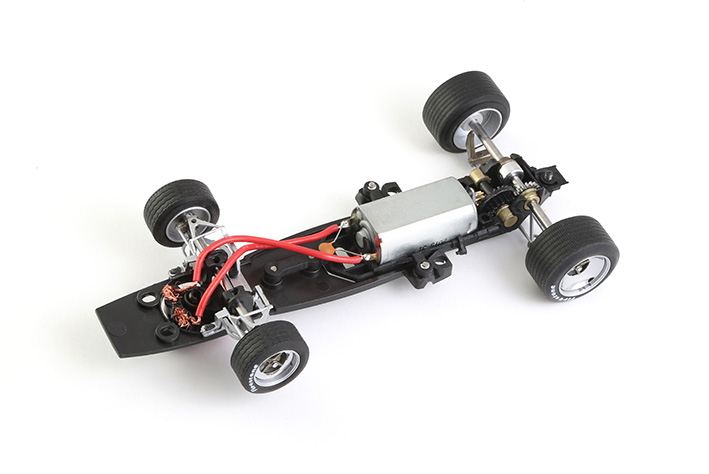
Just like Colin Chapman’s Lotus 72 took the Formula 1 by storm, this first F1 from Policar sets new standards for F1 slot car replicas.
This long awaited model designed by Andrew Rowland and engineered by
Siotit, relies amongst other things on an innovative gear box which enables a proper external replica of the Hewland FG400 gear box. The concept is based around an idle axle with a crown/spur gear combination which transmits power from the motor to the rear shaft.
Power is supplied by a Policar custom designed FF-150 type motor, with one open and one closed face.
The motor, gear box, and axle are housed inside a separate pod, yet another innovation unique to the Policar F1 line, permitting unprecedented levels of tuning and performance for a F1 slot car
A complete line of tune up parts is available separately, including spare motor pods, axles with different gear ratios, pinions, set screw aluminium rear wheels and racing F22 tyres.
The Lotus 72, designed by Colin Chapman and Maurice Philippe in 1969 and refined into 1970, is one of the most important and iconic models in F1 history. It was a great technical achievement and was developed and raced until 1976.
Like ali the cars made by Chapman it set new standards in innovation: inboard brakes, side mounted radiators, torsion bar suspension, motor air intake positioned high beside and then above the driver’s head, wedge shaped nose. The chassis featured a stressed engine, as did the Lotus 49, and the whole package was years ahead of the competition. Driven by Jochen Rindt and Emerson Fittipaldi, it helped both conquer the F1 Driver’s World Championship, twice, as well as bringing home three F1 World Constructor’s titles for Lotus.
Official Lotus drivers for 1970 were Jochen Rindt and John Miles. Rindt quickly put his talent to good use and thanks to the Lotus 72 potential quickly won the Dutch, French, British and German GPs, before dying in a qualifying crash in Monza. He was replaced by Emerson Fittipaldi, who won the US Grand Prix thus helping Rindt win, posthumously, the World Championship. Lotus also won its fourth
constructors’ championship.
This model reproduces the Lotus 72 in which Jochen Rindt had his last F1 Grand Prix win, at Hockenheim in 1970.








